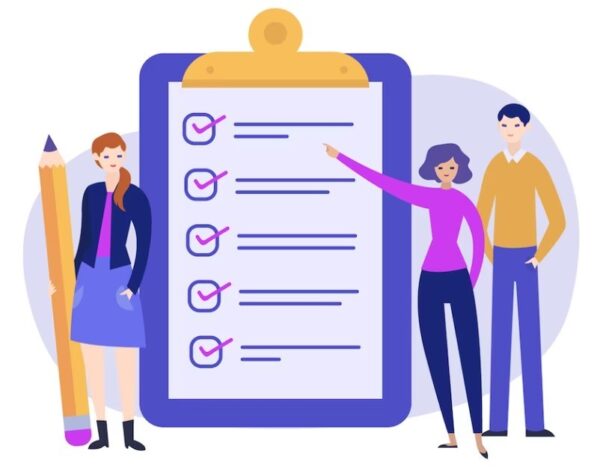What Are Open Ended Questions and How to Use Them in Ecommerce Surveys

Irene Wanja | Aug 31, 2023
Reading Time: 4 minutesWhen seeking deeper insights into your ecommerce customers, you’ve got to ask open-ended questions in your surveys. They’re powerful, they’re probing, and they’ll give you the richest data you’ve ever collected. But what are open ended questions, and how do you craft these questions effectively and analyze the responses?
Let’s dive in!
Understanding the Concept of Open Ended Questions
Understanding the concept of open-ended questions and how they can bring a whole new level of depth to your ecommerce surveys is essential.
So, what are open-ended questions? They are inquiries encouraging detailed, thoughtful responses instead of simple ‘yes’ or ‘no’ answers. They’re a valuable tool in qualitative research, allowing you to delve into your customers’ minds, wants, and needs in a way that multiple-choice questions just can’t match.
Incorporating open-ended questions in your survey design can open doors to insights you never even considered. They allow your customers to speak freely, sharing their unique perspectives and experiences. This can lead to new product ideas, improved services, and a deeper understanding of your market.
But here’s the catch: you’ve got to ask the right questions. ‘What did you think of our product?’ is good, but ‘What changes would you suggest for our product?’ is better. The latter sparks creativity, encouraging customers to think critically and provide concrete suggestions.
The Advantages of Using Open Ended Questions in Ecommerce Surveys
There’s a significant advantage to incorporating this type of query in your online business questionnaires. Open-ended questions give your customers the freedom to express their thoughts and feelings in a way that’s unique to them. They’re not boxed into a corner by limited options. Instead, they’re encouraged to share their authentic perspectives and experiences.
Imagine the rich insights you could glean from such raw data! You’d get a glimpse of what your customers truly think about your products or services. You’d unearth their unspoken needs, their hidden pain points, and the solutions they’re longing for.
Say you’re launching a new product line. Instead of asking, ‘Would you buy this product?’, you could ask, ‘What do you like about this product?’ or ‘How would this product improve your life?’ The responses could be a goldmine of information, helping you tailor your products and marketing strategies to meet your customers’ needs better.
Crafting Effective Open Ended Questions for Your Ecommerce Survey
Crafting the right queries for your online business questionnaire isn’t as daunting as it might appear. In fact, it’s a straightforward process that can yield significant insights into your customers’ experiences, needs, and preferences.
Open-ended questions are your secret weapon. They allow customers to express their thoughts freely, providing you with valuable qualitative data. You’re not restricting their responses to predefined choices. Instead, you’re encouraging them to share their experiences in their own words.
So, how do you craft effective open-ended questions? Start with understanding your goals. What information are you seeking? Are you looking to improve your products, services, or perhaps your customer support? Once you’ve identified your objectives, form your questions around them.
Keep your questions simple, clear, and concise. Avoid leading or loaded questions. You want your customers’ genuine responses, not answers influenced by how you’ve phrased the question.
Remember, you’re not interrogating your customers – you’re engaging with them. So, make it conversational. Use a friendly, approachable tone.
In short, crafting effective open-ended questions for your ecommerce survey isn’t a science, it’s an art. And with a little practice, you’ll become a master artist.
Tips and Strategies for Analyzing Responses to Open Ended Questions
Analyzing the feedback from your online business questionnaire might seem challenging, but it’s an essential step in understanding your customers’ needs and improving your services. Open-ended questions give your customers a chance to express their thoughts freely, providing you with valuable insights. However, you need a strategic approach to interpret this data effectively.
First, sift through the responses and look for recurring themes or commonalities. These patterns can reveal what’s working well and what needs improvement in your e-commerce business. Focusing on the customer’s perspective is crucial, as their experience matters most.
Next, quantify the responses. This might sound counterintuitive for open-ended questions, but assigning numerical values to recurring themes can help you prioritize issues and make data-driven decisions. For instance, if the majority of respondents mention slow delivery, it’s an area that needs immediate attention.
Lastly, use this feedback to drive your actions. If customers are unhappy with a particular aspect of your service, don’t just acknowledge it, work to fix it. This proactive approach will show your customers that you value their feedback, leading to increased loyalty and repeat business.
Final thoughts:
Now that you are aware of what are open ended questions and have seen how powerful they can be in ecommerce surveys. They’re not just insightful, but they also help you better understand your customers.
Crafting them effectively can be a game-changer, and with the right approach to analysis, they’ll provide invaluable insights.
Start using open-ended questions in your surveys and let your customers’ voices guide your ecommerce journey.
Frequently Asked Questions
Your open-ended questions in ecommerce surveys should be brief yet clear. They shouldn’t exceed two sentences. Remember, you’re seeking substantial feedback, not overwhelming your customers with lengthy and complicated questions. Keep it simple and straightforward.
You should include enough open-ended questions to gain valuable insights, but not so many that it overwhelms respondents. Balancing it with closed-ended questions can make your ecommerce survey more effective and engaging.
Absolutely, you can mix open-ended and closed-ended questions in the same ecommerce survey. It gives you a balance of quantifiable data and detailed feedback, helping you understand your customer’s needs and preferences better.
Poorly crafted open-ended questions in ecommerce surveys could include: “What’s wrong with our site?” or “Why don’t you like our product?” They’re vague and negative and don’t guide you to provide constructive feedback.



Table of Contents
Understanding the Concept of Open Ended QuestionsThe Advantages of Using Open Ended Questions in Ecommerce SurveysCrafting Effective Open Ended Questions for Your Ecommerce SurveyTips and Strategies for Analyzing Responses to Open Ended QuestionsFinal thoughts: Frequently Asked QuestionsTable of ContentsAbout the authorLeave a Comment Cancel ReplyAbout the author
Irene Wanja
Irene, a skilled Revenue Optimization Specialist for Build Grow Scale, combines an unparalleled focus on user research and a deep understanding of the ecommerce customer journey to orchestrate optimal shopping experiences. With an uncanny knack for detecting and addressing customer pain points through meticulous user testing, she utilizes tools such as moderated user tests, heatmaps, scrollmaps, and clickmaps to fast-track improvements in user experience and usability. Her keen eye for detail aids in swiftly spotting potential issues and implementing solutions, all while working closely with store owners and applying her intricate comprehension of user interactions. Passionate about software and technology, Irene immerses herself in enhancing her clients' business clarity, efficiency, and user satisfaction. Even though the value of user experience doesn't conform to a conventional numerical scale, the tangible outcomes of her work—improved user experience, amplified retention rates, and reduced customer support issues—are testaments to her prowess. Beyond her revenue optimization skills, Irene is a skilled writer and copywriter. She weaves her profound insights into engaging prose, crafting content that not only resonates with diverse audiences but also demystifies the complexities of user experience, consequently benefitting businesses worldwide.




